Trekking the primary jungle in Kalimantan (Part 1)
Seeing the primary jungle has always been a big dream for us. Knowing that it will probably be the last or second last generation to be able to see it, we decided to go for it this year. As we have had good experience in the past with Indonesia, and Kalimantan having one of the biggest jungles, it was quickly decided. We would go to trek the Kalimantan's primary jungle. It would be one of most challenging but also rewarding experiences.
Preparation
Wikipedia describes Kalimantan as follows:
"Borneo (/ˈbɔrnioʊ/; Indonesian: Kalimantan, Malay: Borneo) is the third-largest island in the world and the largest island in Asia. At the geographic center of Maritime Southeast Asia, in relation to major Indonesian islands, it is located north of Java, west ofSulawesi, and east of Sumatra.
The island is divided among three countries: Malaysia and Brunei in the north, and Indonesia to the south. Approximately 73% of the island is Indonesian territory. In the north, the East Malaysian states of Sabah and Sarawak make up about 26% of the island. Additionally, the Malaysian federal territory of Labuan is situated on a small island just off the coast of Borneo. The sovereign state of Brunei, located on the north coast, comprises about 1% of Borneo's land area. Borneo is home to one of the oldest rainforests in the world."

Overview of Kalimantan
Giving the remoteness of the area, our knowledge of the region and the fact, that only a fool trek alone in an unknown part of the jungle, we looked for a guide. A quick research lead us to Kompakh. Kompakh is a local tour operator based in Putussibau, in Western Kalimantan. After a few emails all was clear and we had our trip planned.
On the first day we would go by boat from Putussibau to Nanga Hovath, where we would meet our local guides. On the second day we leave early by boat to the starting point of the jungle trek. Followed by three stages of around 6km of trekking. Sleeping in a simple jungle camp on day two and three. After the third stage a boat would pick us up and bring us back to Nanga Hovath for the night (day four). On day five we returned to Putussibau.

Overview of the trekking region.

The three stages of trekking
We arrived in Putussibau a few days before the actual trip. That gave us some time to acclimatise and to know the guide. Our guide's name was Eduardus, called Edo. He speaks english and would translate between us and the local people and local guides.
Our adventure started on September 8th, 2015.
Getting to Nanga Hovath
Nanga Hovath is the last village before the Bitung Kerihun National Parc. To get there you take a longboat for around 3h. Our boat was between 9 to 10m long and just 60 to 70cm wide. Because of the dry season, the river was low. That made the ride a little faster, but our guide Edo had to help the boatman to stalk the boat through shallow places in the river.
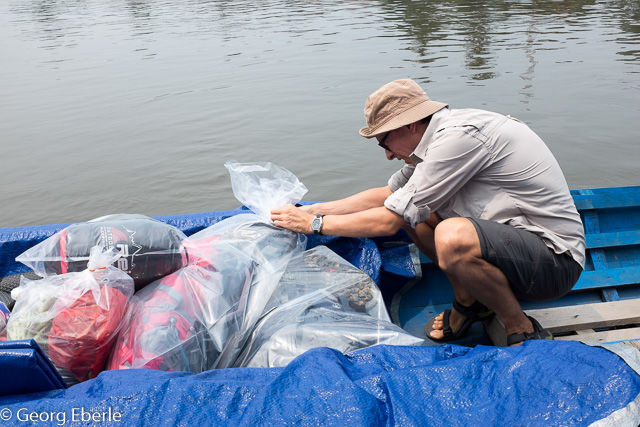
Packing everything in plastic bags to protect against water.

Our longboat with our gear.

Riding up the river. Edo is on the watch.

An improvised ladder.
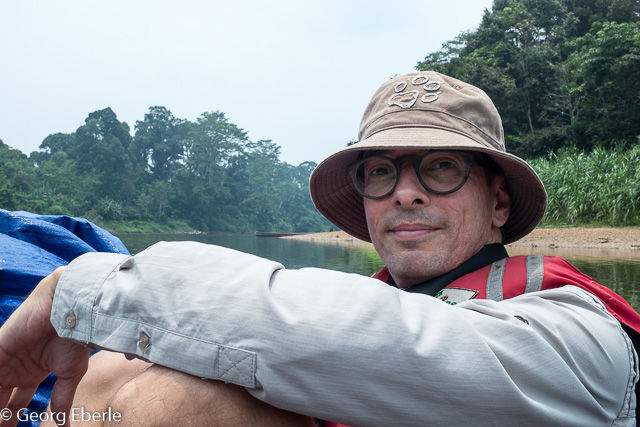
Me, relaxed and happy.

Houses at the river.

This group of men where sawing down the big tree.

It's a fast ride, when the water is deep enough.

Sometimes Edo had to stalk.

Dense vegetation and haze.
The haze came from the more than 2000 (!) bush fires in West Kalimantan. It is a common problem in the region during that time of the year (Article 1 and Article 2). Local farmers burn down vegetation to clear old rice fields and Oil Palm plantations burn large patches of forest for exploitation. This year the haze is especially dense, due to a strong El Ninõ effect. Side effect for us: we wouldn't need sunscreen.

Exploring the Nanga Hovath village after 3h of boat ride. The village was almost empty, as everyone was working on the rice fields.
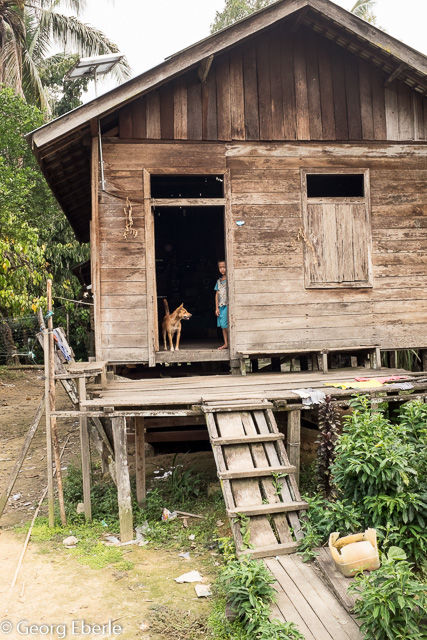
A child and an dog, to guard the house.

We set up our mosquito net for the night. It gets dark shortly after 5pm. Actually it should be 6pm, but I couldn't find out why. They have not introduces daylight saving time.
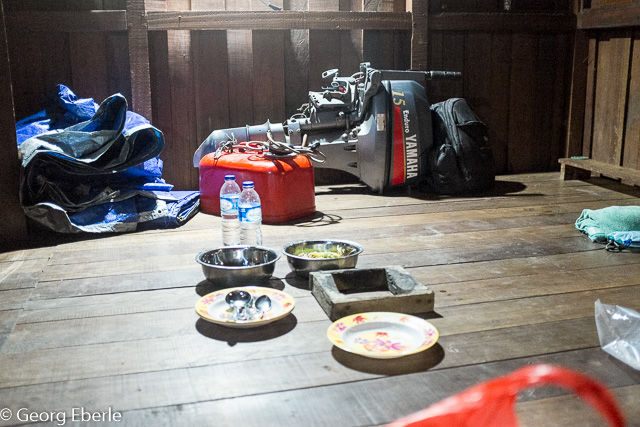
Our boat driver took literally everything from the boat to our hut. Even the engine. He said, because of security...

Meet our local guides.
They came to us at around 7pm. Edo negotiated for the upcoming trip. Notice the two waterbottles? They contain Arak, not water. They buy the Arak in 1/2 litre plastic bags. They poured it in the empty bottles to make it easier to fill into glasses.
We went to bed early and slept on the floor until 5am next morning. As soon as it gets light, the cocks start to cark and the dogs bark. Natural alarm clock.
Stage One
We took an early bath in the river. The water is always warm. That makes it very enjoyable. When we returned, our coffee was already waiting for us. While we sipped our indonesian kopi, our guide prepared our breakfast: rice with salted fish.

Our hut.
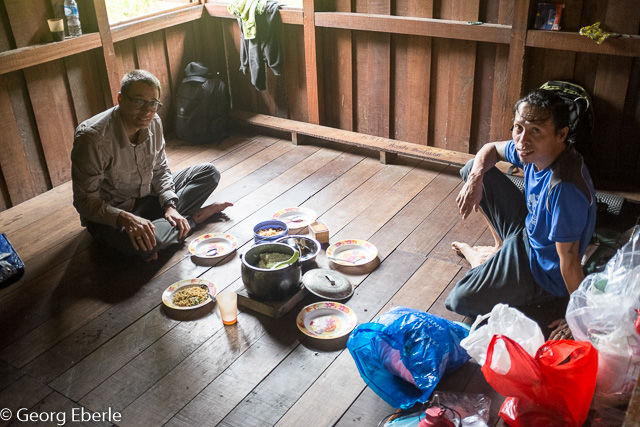
Breakfast is ready.

Our guides put everything in their "rucksacks"...

...under the watchful eyes of their wife and children.
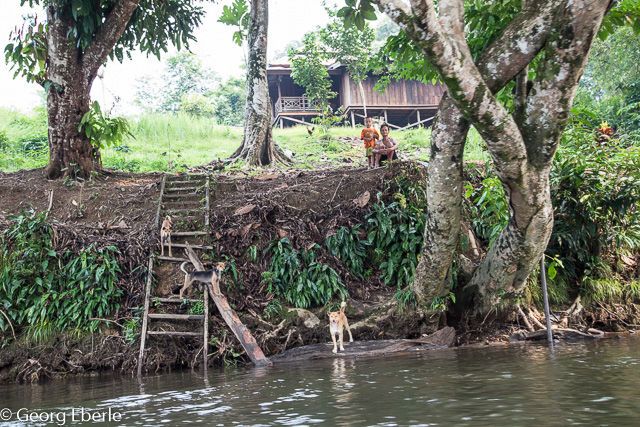
When we left, the dogs came to check.
After another 1.5h of boat ride, we reached the starting point of our trekking tour.
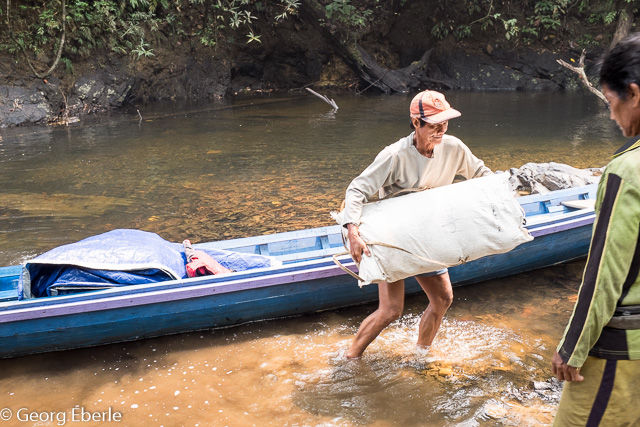
Unloading the boat.

A little rest, before we start.
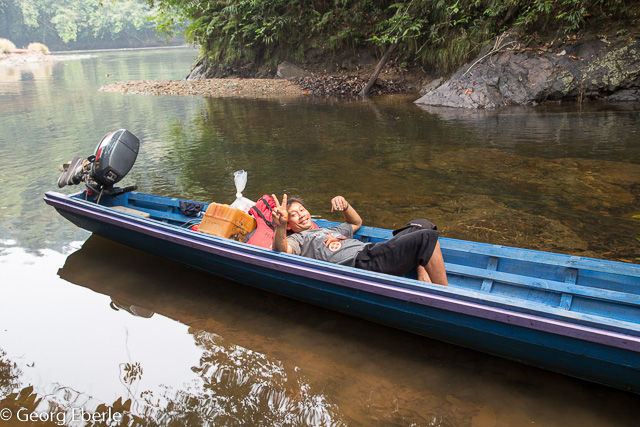
The captain has done his job for today.
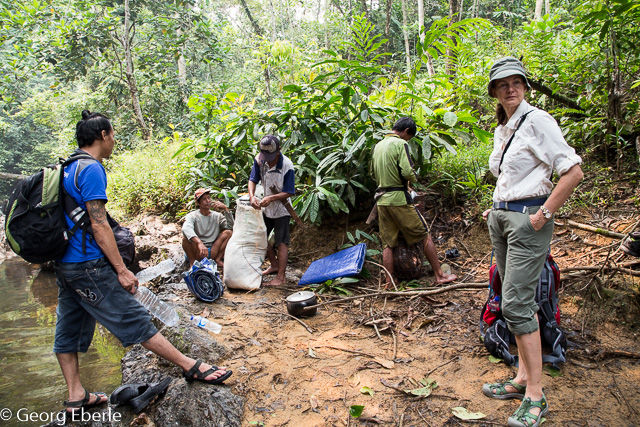
Getting ready 1.

Trekking start in this little river.

Getting ready 2.
Everyone gets a glas of Arak before we start.
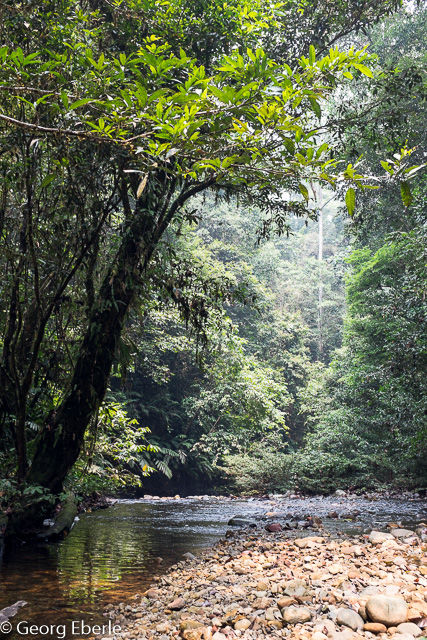
The trek is a mix of wet and dry. About half of the time we walked in the water.

A huge tree has fallen across the river. A first magical moment in the forest.

Wading through the water.

Simple beauty.
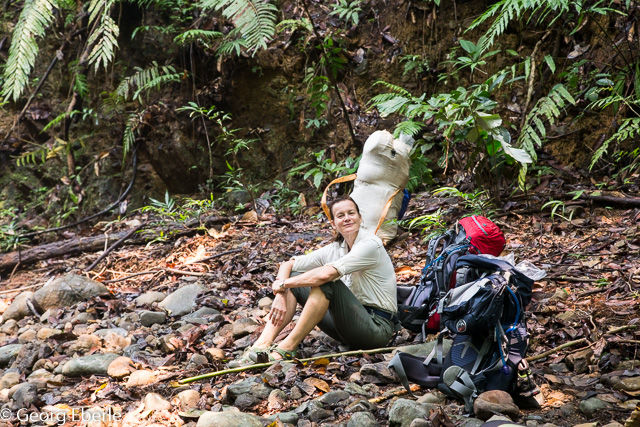
A well earned rest for us...

...and our guides.
They would walk for around 40min and then rest for 15-20min. Walking in hot and very humid condition is a lot more strenous than one would think. We are used to walk with backpacks for several ours. But in the jungle it is different. Heat is a problem. And then there is ratan loops on the ground, and thorns at the leaves. If you concentrate on only one, the other will get you sooner or later. We had a good share of stumbling and being held back by thorns that hold your hair, shirt or arms.
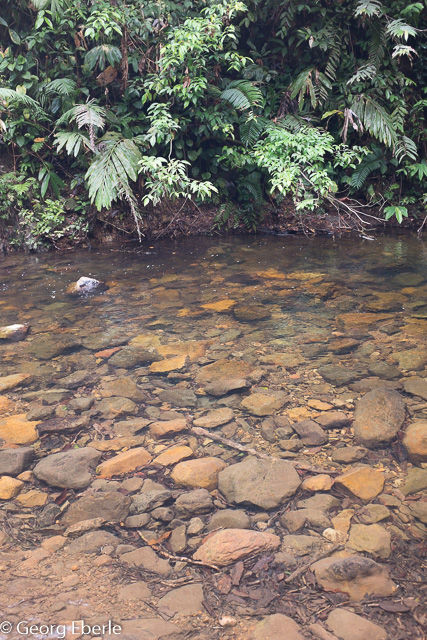
The water is extremly clear. Our guides drank it without filters.
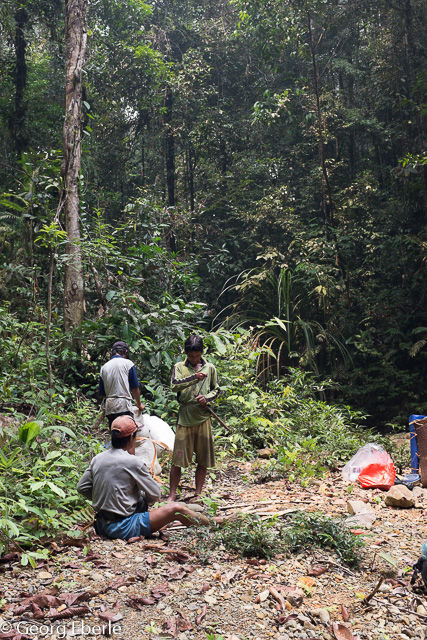
Resting.
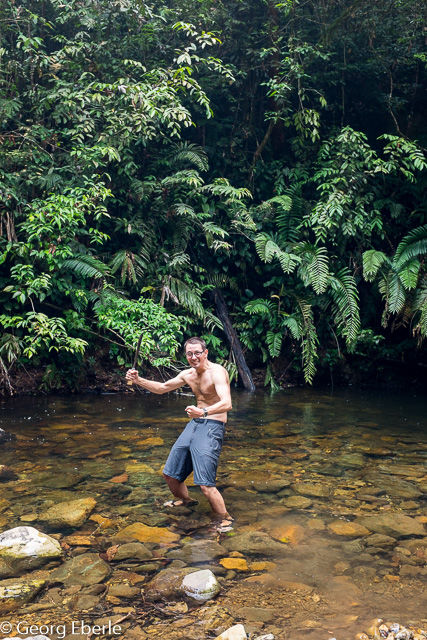
Making a little fun (Putin style).
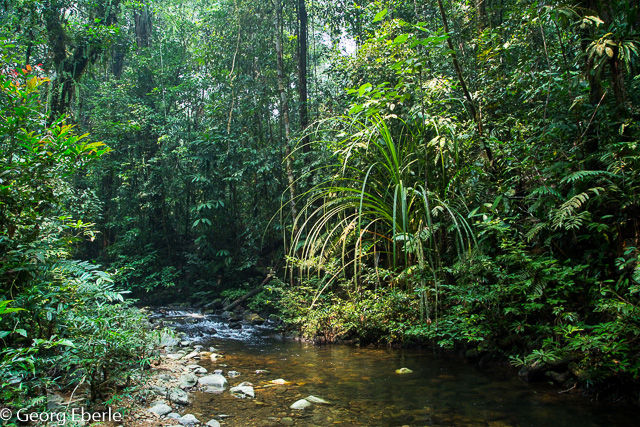
Beautiful river.

Another big tree.
After 6h of trekking (including rests) we arrive at a water hole with a small waterfall. Time to take a bath. Our cloth are so soaked, that it doesn't make any difference. They are as wet as if we would have been swimming.

Our guides are looking...
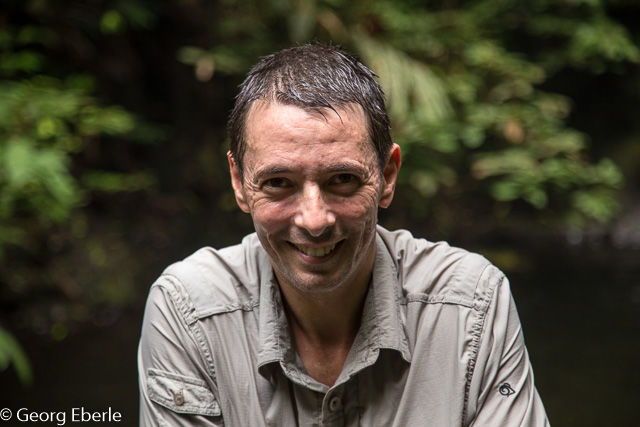
...I am swimming.

Cooling down in the water hole.
After our bath, we climb to our sleeping place. The guides begin to set up our simple tent. We change to our dry set of cloth, explore the area and watch them getting ready.

Setting up the tent.

Preparing fire wood.
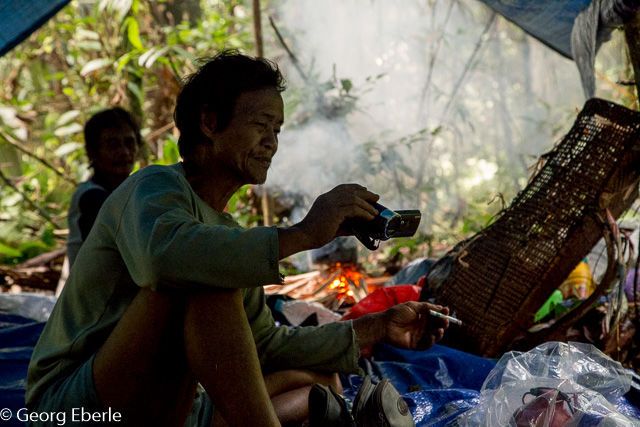
Checking todays videos.

Our tent in the jungle.

Our wet cloth.
They would not dry during the night. The next morning you put them on wet. As it is warm, it is not a problem. Except from the smell maybe.

After dinner, everyone is tired.
To be continued in part 2.


